There are tons of 12V batteries out there, do you know which ones are the best RV batteries for boondocking.
Here we have listed 5 best options for your next outdoor trip.
All of the batteries below are 100-amp hour, 12 volt deep cycle batteries.
Let's check out which deep cell battery is best for your setup!
5 Best RV Battery for Boondocking?
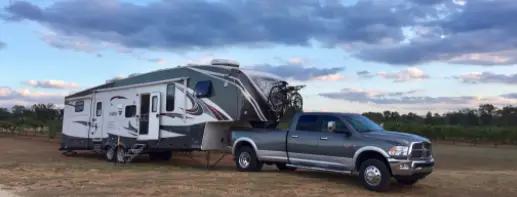
Disclosure: All products have affiliate links to commission to support the website when you purchase
Battle Born 12V 100 Ah LiFe PO4 Deep Cycle Battery
Why we picked this one - Customers across the board really love Battle Born’s products. Multiple reviews talk about how easy it is to install due to its light weight, how quickly it takes a charge, and how surprised they were at its resistance to high temperatures. 89% of customers gave this battery five stars.
Built-in BMS System: Protects the battery from failure due to unstable conditions caused by overheating, ground faults, and more. It also manages the discharge/charge cycle of the battery to make it last longer.
Increased Longevity - Charge & discharge repeatedly and faster than any other batteries
Safer Use - Li-Ion batteries can be safer than Lead Acid batteries, which have no protection against ground faults
Green Energy - Nontoxic, safe and reliable power source to keep the environment eco friendly
Various Applications - Use it to power 12v, 24v, 36v and 48v systems for a wide range of off grid applications
Product Specifications:
- This battery has parallel and series support and is rated for 100 Ah,
- 100 amps of continuous charge current
- 4,000 discharge cycles on average
- 31 pounds
- sized as 12.8 x 6.9 x 9 in
Why we picked this one as #2 - Renogy is a well known and respected brand in the RVing community. Consumers boast about their batteries long discharge cycles, as well as Renogy’s prompt and helpful customer service. Customer reviews of this product are almost unanimously positive with 74% of people giving the brand five stars.
Built-in BMS System: Just like the Battle Born 12V battery with the built-in battery management that scans and protects against abnormal conditions while also monitoring and managing the charge/discharge process.
Increased Range of Temperature Resistance: This battery has parallel connections and is even capable of discharging in temperatures ranging from -4 – 140 °F.
Product Specifications:
- Lithium-ion-phosphate battery has 100 Ah
- 50 amps of continuous charge current
- 4,000 discharge cycles
- Weighs 26 pounds
- 15 x 11.5 x 10 in. $760
Why we picked this one - Customer reviews speak highly of this product and 92% of people gave a five-star review. The downfall of this battery is that its recommended discharge depth is only 50%.
Special Treated Alloy Plates: This product has specially treated plates to enable low internal resistance, reduce the self-discharge rate, and even increase discharge currents up to ten times the battery’s rated capacity!
Practicality: This battery is advertised as a practical and reliable choice for your daily power needs. The Renogy AGM offers similar discharge power at a quarter of the price of the lithium batteries above.
Product Specifications
- The Renogy AGM battery offers 100 Ah at a ten-hour discharge rate
- 30 amps of continuous charge current
- Weighs 64 pounds
- Sized as 13.1 x 6.9 x 8.6 in
Why use this one - While 65% of customers gave a five-star review, many customers were unfortunately upset by the battery’s short lifespan.
Spiral Cell Technology: This AGM battery is made with 99.99% pure lead and uses precision-controlled spiral cell technology allowing the battery to output more power than its flat-plated opponents. Optima batteries are 15x more resistant to vibration than other AGM batteries on the market.
Dual Purpose Capability: This battery is unique in that it is dual purpose, meaning it can be used as a deep cycle and a starting battery allowing you to run quick and high power drawing applications such as an AC unit without shore power.
Product Specifications:
- This AGM battery offers about 92 Ahs
- 800 cold-cranking amps
- 140 minutes of reserve capacity
- Weighs 54 pounds
- Sized as 8.75 x 12.19 x 6.81 in
Why Pick This One? While there were far fewer reviews to reference for this product, 56% of customers gave this brand a five-star rating.
Safety Standards: This battery is a standard AGM battery offering vibration resistance, and the non-spill acid proof outer body.
Maintenance Free - Keep it active without spending much time maintaining it because it's a Deep cycle AGM battery
Faster Charge - Charge 5X faster than the flooded version, and the ability to deep cycle completely discharged without being damaged as quickly as a normal battery
Cost Effective Option: This battery offers no fancy add-ons but is a budget friendly option and a very reliable battery.
Product Specifications:
- The Universal UB121000 stores 100 Ahs of charge
- Deep Cycle AGM
- 12V
- Weighs 65 pounds
- Sizes as 13 x 6.73 x 8.46.
Difference Between Dry Camping and Boondocking?
Dry camping and boondocking are very similar. In both scenarios you are living off the grid in your RV or camper trailer. The only difference is that dry camping is at a developed campground.
Boondocking is at a wild site or on BLM land designated for recreational use. This means you are camping at an undeveloped location away from any services or amenities.
How to Choose the Right Boondocking Battery
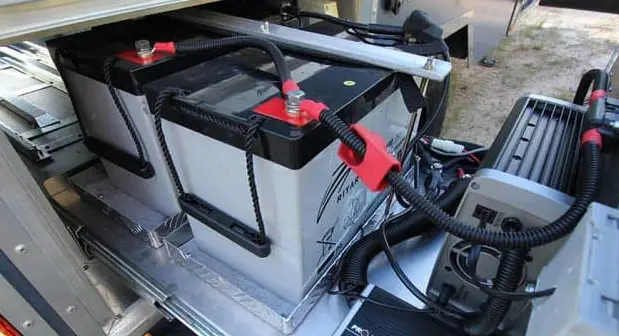
Your choice in battery can make or break your camping experience! It is an important decision, and once you start shopping you will realize just how many types of batteries there are to choose from.
There are many things to consider when choosing the best RV battery bank for your setup.
We have listed five of the most important things to consider below.
Starting Battery vs House Battery
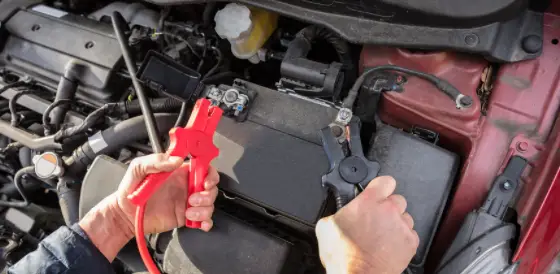
Starting batteries are designed to carry a large load for a short amount of time. They are used for sending a surge of power to assist in igniting a mechanical operation. The most common use for starting batteries is cars.
Think about what happens when you start your car. You turn the ignition, and the engine revs on. The battery needs to draw enough power to engage the starter, but then the engine takes over and the battery is not under nearly as much stress for the rest of the time the car is running.
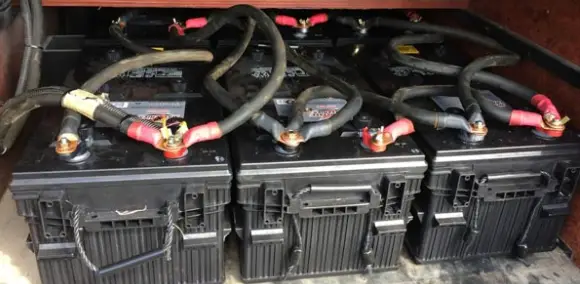
An RV electrical system operates more like a home, hence the term house battery. Imagine a typical morning in your RV. Maybe your phone is charging, and you are playing music over the speakers. You have a light turned on over the stove because its still a little hazy outside. Your coffee is brewing on the countertop.
Then take into consideration the things that may be running in the background such as your fridge and your water pump. This is a steady draw of current happening over a long period of time. This situation requires a deep cycle battery, also called a marine battery.
Electrolyte Technology
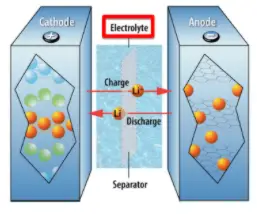
The majority of batteries operate by suspending a charge between half cells within an electrolyte solution. This solution is comprised of sulfuric acid and water. There are two half cells within the battery. One is a hydrogen half cell and one is lead dioxide.
The solution helps to prevent corrosion of the battery plates which would cause long-term damage and could even end your battery’s life.
With the exception of lithium ion batteries, which use a mixture of lithium salt and organic additives to form the electrolyte solution, all battery types operate using the same technology. Therefore, it is not something necessary to be considered when purchasing a battery.
What does need to be considered is the level of the electrolyte solution. Some batteries are filled to the rim with this solution, causing it to bubble over when the battery heats up. This is a toxic solution, and it can cause severe damage if it comes in contact with your skin. It isn’t even safe to breath in the fumes.
We suggest choosing a battery type that does not risk you accidentally encountering the electrolyte solution. This will be explained in greater detail in our explanation of the types of deep cycle batteries.
Depth of Discharge & Discharge Cycles
Depth of discharge refers to how low you can let your battery get before it infringes on the overall lifespan of your battery. Most deep cycle batteries are rated to discharge to 80%, meaning that it is safe to drain your battery down to 20% of its capacity safely time and time again.
Discharge cycles refers to the amount of times a battery can be drained to its capacity and recharged again for use in the battery’s lifetime.
For example, a battery rated for 150-200 discharge cycles at an 80% depth of discharge can withstand being drained to 20% capacity 150-200 times before the battery will start to go bad. After this, the battery will begin to lose charge more rapidly and will eventually need to be replaced.
If you were to discharge this battery to 90 or 100% it would reduce the number of discharge cycles you would get out of the battery.
Many deep cycle batteries have similar ratings as far as discharge depth/cycles go. It is something that should be considered when choosing between two battery options. However, this information is more relevant for maintaining the longevity of your battery after installation.
Durability Due to Vibration

Vibration is inevitable on the road. What does this mean for your battery?
Vibration and jolting can cause the electrolyte solution to spill, which as stated earlier can lead to corrosion of the battery plates. The vibration itself can lead to a cracked battery case, as well as cracks in the cell connectors and separators.
Some types of batteries are built to withstand vibration better than others.
Weight
Deep cycle batteries are large and heavy additions to your setup. Some high-end batteries are only thirty pounds, but the majority of marine batteries weigh in at upwards of sixty or seventy pounds!
While this may be something you may need to take into consideration for balancing with a fifth wheel or small trailer, most set ups will not be affected by this amount of weight.
The main things to take into consideration regarding weight are:
- Can the surface you are placing it on hold the weight of the battery? If not, you may need to add extra support.
- Will you be able to lift and move the battery if needed for maintenance or storage?
Types of Deep Cycle Batteries
Lithium Ion Battery
This is the most efficient, longest lasting battery on the market today. In turn, this is the most expensive type of battery on the market today.
This battery ticks off everything on our list. It is a deep cycle battery with no sulfuric acid and an organic electrolyte solution. It has a nearly 100% discharge rating with more discharge cycles than any other type of deep cell battery available today. It is resistant to vibration and extremely light weight.
While the benefits of the battery are great, it is completely unnecessary for most people’s use considering the hefty price tag that comes attached. On average, these batteries sell for three times more than a comparable AGM battery.
Lead-Acid Battery
This is the most common type of battery, and there are many subcategories of lead-acid batteries, beginning with flooded and sealed.
Flooded Battery
We call a standard lead-acid battery a flooded battery because the electrolyte solution in this battery is filled to the top of the battery case, and it is up to you to keep the solution from falling below this designated level.
These batteries emit toxic fumes, can spill battery acid due to vibration, and require a fair amount of potentially hazardous hands on maintenance. These batteries can only be installed upright, and cannot be used or stored in an enclosed space. Whether the battery compartment is inside the camper or not, we do not recommend flooded batteries!
Sealed Battery
Sealed batteries require much less maintenance and are a safer alternative. There are two types of sealed lead-acid batteries:
AGM Battery
AGM, or absorbent glass mat batteries are made from fiberglass mats that lock the electrolyte solution inside the battery. These are also referred to as starved acid batteries due to the shallow level of electrolyte solution in comparison to its flooded counterpart.
Gel Battery
Gel batteries do away with the liquid solution all together and instead have a gel paste inside that hold the electrolytes.
Both sealed batteries are safe, non-spill options and both are vibration resistant. Our research shows that AGM is the better choice however as it less sensitive to high voltage input levels and is a more affordable option.
Unfortunately, all lead-acid batteries are heavy and take up a fair amount of space in comparison to lithium-ion batteries which can be up to 70% percent lighter overall.
Common FAQ
There is so much to learn when it comes to RV batteries. Below are a few of the most common questions we get. We hope this helps!
How Much Battery Power Will I Need for Boondocking?
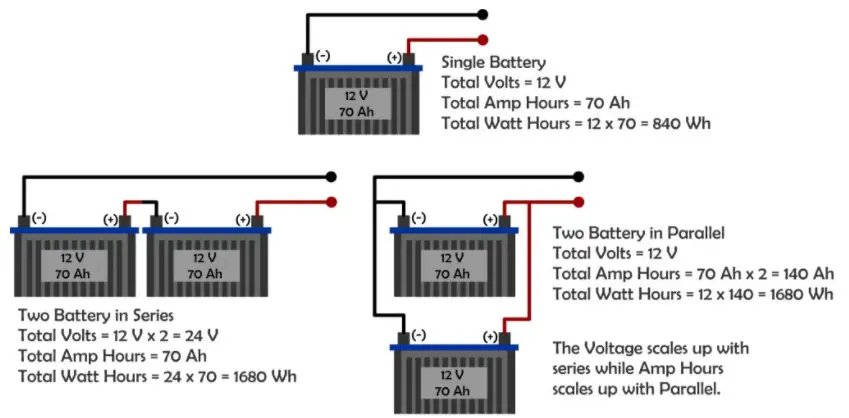
Amps are calculated by dividing watts by volts. So, a 100-watt lightbulb running at 12 volts requires about 8 amps (100/12).
Multiply this by the hours the lightbulb will be in use to get amp hours, meaning that ten hours of use will burn up 80 Ah (8*10).
Add up the rest of your journal this way to find out how many Ah you need per day, and then multiply this by the number of days you want to be off-grid and Wa-lah! You have your minimum battery size.
Next comes the fun part. Find out the Amp hours needed from every electric device and appliance you listed in your daily usage journal. You can usually find the required wattage on the product, in a user manual, or online. There is a simple formula to use to determine the amp hours required.
There are a few caveats to this formula. For example, an item running at a high load such as an air conditioner or a blow dryer will kill your battery life faster. For these items, you should double the number of Ahs needed.
You should also take into consideration that even the best deep cycle battery should not be completely discharged. To be safe, you want the battery to have at least 20% of its storage full at all times. To account for this, multiply your end number by (.8) or 80%.
The amount of battery power needed for boondocking and dry camping varies greatly from person to person. Some people prefer to barely use their RV while camping, spending their time cooking over a bonfire and eating by lantern light under the stars. Other people will want their RV to supply them with the same comfort and routine that they are accustomed to in their standard brick and mortar homes.
What batteries are compatible with solar systems, and which is the best option for your setup? Luckily enough, any deep cycle battery can be wired to a solar array. This includes all five of our choices listed in the article.
You have purchased and installed your battery and are ready to hit the road! Do we have any last tips for you before you set off?
The best way to determine how much battery power you will need for dry camping or boondocking is to start by imagining your ideal day camping.
Can You Use a Regular Car Battery in an RV?
The more important question here is- Should you use a car battery in your RV?
And the answer is no.
Car batteries are starting batteries. As we learned earlier, this means that they are designed to carry a large load for a short amount of time. Since your camper operates more like a home, it should be running off a deep cell RV battery.
In a pinch, you could put a car battery in your RV and it wouldn’t cause any damage to your converter or any of your electrical appliances. However, this will quickly diminish the lifespan of the battery, and you most likely will lose charger faster than you would with a proper battery installed.
Can You Store an RV Battery in Your House?
If you don’t follow the snowbirds south for the winter and you have no interest in exploring glacier peaks, then you may find yourself wondering what to do with your deep cycle AGM battery while your RV is in storage for the winter.
But wait? Can’t you just leave it in the RV until spring?
Unfortunately, this is seldom an option. As your battery depletes itself, it grows more and more susceptible to freezing. This not only shortens the life of your battery but can even be fatal if it should cause the casing to crack.
Even if your RV is stored in a location with mild temperatures, you may still need to take the battery out. Deep cycle AGM batteries are not meant to be fully discharged. Even with no load, the battery will still gradually drain itself in time. Leaving the camper plugged in doesn’t lead to certain safety either as this could cause damage by overcharging the battery or even start an electrical fire.
So how should you store your RV battery?
To ensure safe storage, you should keep your battery in a warm, indoor location. A well-insulated garage or heated shed should suffice as long as the battery is kept on a trickle charger or periodically brought back up to a full charge. Keep a piece of cardboard or similar material underneath the battery to prevent damage from moisture.
You can store your battery in your house safely so long as it is a sealed battery. (AGM batteries are sealed and safe to store inside.) A non-sealed battery can release fumes that are very toxic and should not be stored inside.
What is the Best Deep Cycle Battery for Solar?
If you want to check out more battery options please click here to view our Solar RV battery guide.
The only thing you need to check before connecting is that the voltage is compatible, meaning that both systems run at the same number of volts. A 12-volt panel must be paired to a 12-volt battery system, and a 24-volt panel must be paired to a 24-volt battery system.
Again, this is rather simple to accomplish as most RV solar panels and batteries run at 12-volts.
Other RV Boondocking Tips
For your first time boondocking, we suggest going for a shorter period of time than you may initially be striving for. Most designated boondocking locations have a 14 day stay limit, and it is tempting to jump right in and get your full two weeks.
Though these locations are typically more user friendly than true wild, dispersed camping with other people set up nearby and maybe even services within a reasonable drive, it is hard to truly know what you’re the location has to offer until you get there.
While you are still learning how to ration your power, water, food, and other resources it is best to stick to shorter stays. Go out for a weekend and see how you manage before taking the fourteen-day plunge!
Of course, you don’t have to go in completely blind. With the nomadic community growing larger by the day, information has become available at our fingertips. The adventurous days of following forest roads on a map in hopes of landing on a piece of gold (meaning your remote piece of wilderness with enough space for the campervan) are over for better and for worse.
Today, you can pick up your phone and have a listing of the closest fifty places to stick your RV for the week along with pictures and reviews. Many times, the reviews even give reports of how much cell-coverage is available and if there is enough open canopy for efficient solar.
Some of our favorite resources are :
- Campendium
- Free Campsites
- iOverlander
even has filters to show you nearby dumps, water fills, day use parks, and attractions.
We suggest packing extra tools including a hatchet or a hack saw. It is best to collect firewood from the area you are camping in rather than supplying your own.
Not only does this cut down on storage space in your rig, but also prevents the spread of infectious insects and fungi to areas with no resistance to the newcomers. Of course, always check local laws to make sure it is legal to collect firewood where you are camping. If you do purchase your firewood, please purchase local!
And lastly, bring your hobby! There is nothing more fulfilling than enjoying your favorite thing in the middle of pristine wilderness. You can make jewelry, birdwatch, play music, dance, read, or paint. The options are endless.




